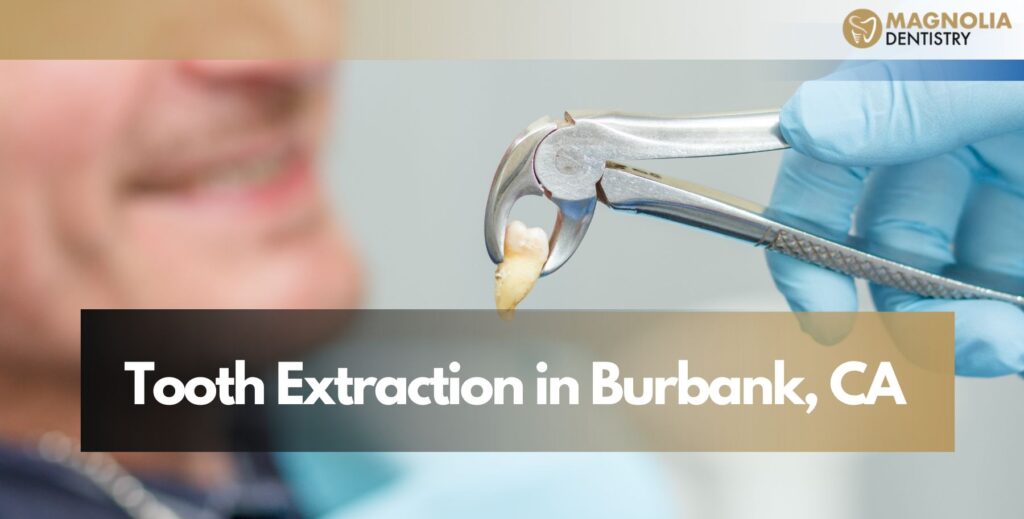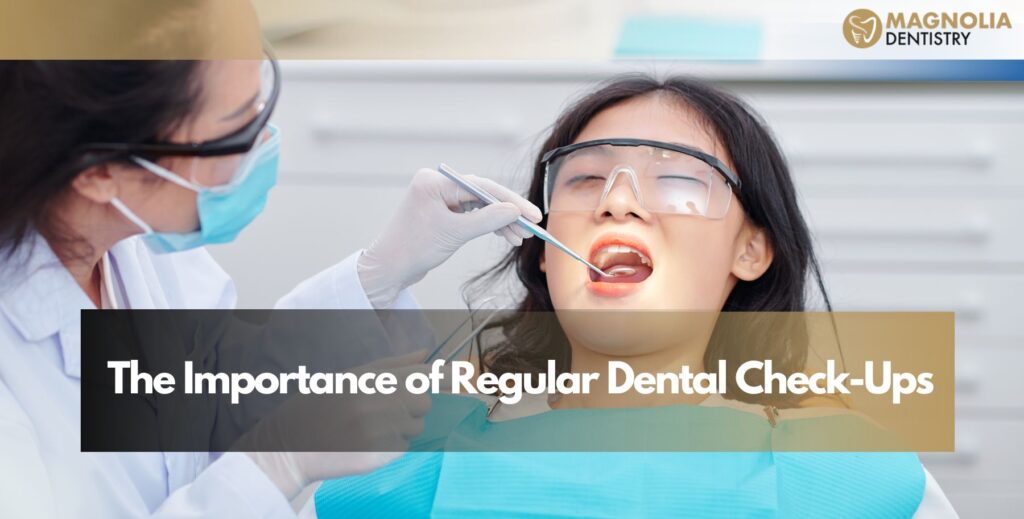Tooth extraction is one of the most common yet important dental procedures designed to protect your oral health and relieve pain caused by infection, damage, or overcrowding. While the idea of removing a tooth can seem intimidating, modern dental techniques have made the process safe, comfortable, and efficient.
At Magnolia Dentistry, Dentist in Burbank, CA, we provide gentle and precise tooth extraction procedures to ensure minimal discomfort and faster recovery. Our focus is on preserving your overall oral health, preventing complications, and maintaining the beauty of your smile.
What Is Tooth Extraction?
Tooth extraction is the removal of a tooth from its socket in the bone. It’s typically performed when a tooth is severely decayed, damaged beyond repair, or poses a risk to the surrounding teeth and gums. Depending on the condition, an extraction can be simple (performed on visible teeth) or surgical (used for impacted or broken teeth beneath the gum line).
Types of Tooth Extractions Near You in Burbank, CA
Tooth extractions can vary based on the tooth’s position, condition, and complexity of removal. Understanding the different types of extractions helps patients know what to expect during their treatment.
Simple Extraction
A simple extraction is performed when the tooth is visible above the gum line. Using specialized dental instruments, the dentist carefully loosens and removes the tooth under local anesthesia. This procedure is quick, minimally invasive, and typically involves a short recovery period with little discomfort.
Surgical Extraction
A surgical extraction is a more advanced procedure used for teeth that are broken, impacted, or have not fully erupted — such as wisdom teeth. During this process, the dentist makes a small incision in the gum and may remove a small amount of bone to safely access and extract the tooth. This ensures a thorough and safe removal while minimizing trauma to surrounding tissues.
When Tooth Extraction Is Necessary
Tooth extraction is often a last resort when restorative treatments like fillings, crowns, or root canals are no longer viable. It’s a preventive measure that protects the rest of your mouth from potential infection and discomfort.
Common Reasons for Tooth Extraction
Tooth extraction is generally a last-resort procedure, recommended only when a tooth cannot be saved through restorative treatments like fillings, crowns, or root canal therapy. There are several circumstances in which removing a tooth becomes necessary to protect your oral health, alleviate pain, and prevent further complications.
Severe Tooth Decay or Infection
When tooth decay reaches deep into the pulp — the innermost layer of the tooth containing nerves and blood vessels — bacteria can cause a serious infection. In some cases, root canal therapy may not be enough to save the tooth. If the infection spreads or causes significant damage, extraction becomes necessary to stop the infection from reaching the jawbone or adjacent teeth.
Advanced Gum Disease (Periodontitis)
Gum disease, also known as periodontitis, can gradually weaken the bone and tissues that support your teeth. As the condition progresses, teeth may loosen or shift out of place. If the bone structure cannot be restored through periodontal treatment, tooth extraction may be required to prevent the spread of infection and maintain the stability of surrounding teeth.
Impacted Wisdom Teeth
Wisdom teeth are the last molars to emerge and often lack enough space to erupt properly. When they become impacted (trapped beneath the gum), they can cause significant pain, swelling, and pressure on nearby teeth. Extracting impacted wisdom teeth prevents infections, cysts, and misalignment, protecting the overall structure of your smile.
Overcrowding or Orthodontic Reasons
In some cases, tooth extraction is part of a larger orthodontic treatment plan. When the teeth are overcrowded or misaligned, removing one or more teeth helps create enough space for braces or aligners to move the remaining teeth into proper alignment. This ensures a balanced, healthy, and aesthetically pleasing bite.
Fractured or Broken Teeth
Severe dental trauma can cause a tooth to break near or below the gum line. When a tooth is too damaged to be restored with a crown, filling, or bonding, extraction becomes necessary to prevent pain and infection. Removing the damaged tooth also helps maintain the integrity of your surrounding teeth and gums.
Preparation for Dental Implants or Dentures
Sometimes, extractions are performed as a preparatory step for future dental restorations, such as implants, bridges, or dentures. Removing unhealthy or damaged teeth ensures a clean, stable foundation for your new restoration. This proactive approach helps improve the long-term success and comfort of your replacement teeth.
The Procedure of Our Tooth Extraction in Burbank, CA
At Magnolia Dentistry, we make the tooth extraction process as smooth and painless as possible through advanced techniques, precision, and personalized care.
Consultation and Examination
Your treatment begins with a detailed consultation and digital X-rays to assess the tooth’s position, root structure, and overall oral condition. The dentist will discuss your symptoms, explain the procedure, and recommend the best extraction method for your situation.
Anesthesia and Sedation
To ensure maximum comfort, local anesthesia is administered to numb the area around the tooth. For patients with dental anxiety or more complex cases, sedation options are available to help you stay relaxed throughout the procedure.
Tooth Removal
Simple Extraction Process
For visible teeth, the dentist uses a dental elevator to loosen the tooth and gently remove it with forceps. This process is quick, minimally invasive, and usually takes only a few minutes.
Surgical Extraction Process
For impacted or broken teeth, a small incision is made in the gum to access the tooth. If necessary, the tooth may be divided into smaller sections for easier removal. Once removed, the area is cleaned, and stitches may be placed to promote healing.
Post-Extraction Care
After the procedure, the dentist will provide detailed aftercare instructions. You’ll be asked to bite down gently on a gauze pad to control bleeding. Ice packs may be used to reduce swelling, and over-the-counter or prescribed medication can manage discomfort.
Healing and Recovery After Tooth Extraction
Proper aftercare is crucial to ensure smooth healing and prevent complications such as dry socket or infection.
Immediate Aftercare Tips
- Keep the gauze in place for at least 30–45 minutes after the extraction.
- Avoid rinsing, spitting, or using a straw for 24 hours to allow a blood clot to form.
- Apply an ice pack intermittently during the first few hours to reduce swelling.
Diet and Oral Hygiene
Stick to soft foods such as yogurt, mashed potatoes, and smoothies for the first 24–48 hours. Avoid hot, spicy, or crunchy foods that could irritate the extraction site. Continue brushing and flossing carefully but avoid the surgical area.
Long-Term Healing
Most patients experience full recovery within 7–10 days, though healing times may vary depending on the complexity of the extraction. If sutures are used, your dentist will schedule a follow-up visit to ensure proper healing.
Possible Complications and How We Prevent Them
At Magnolia Dentistry, we take every precaution to prevent post-extraction issues. However, understanding potential complications helps patients stay proactive during recovery.
Dry Socket
Dry socket occurs when the blood clot at the extraction site dislodges or dissolves prematurely, exposing the bone. To prevent this, avoid smoking, drinking through a straw, or rinsing vigorously after surgery.
Infection
While infections are rare, they can occur if bacteria enter the extraction site. Proper oral hygiene and prescribed antibiotics help minimize the risk.
Swelling and Discomfort
Mild swelling is normal and typically subsides within a few days. Ice compresses and pain relievers can effectively manage discomfort during recovery.
Tooth Extraction and Dental Restorations
Losing a tooth doesn’t mean you have to live with a gap in your smile. After healing, several restorative options can replace missing teeth and restore functionality.
Dental Implants
Implants are the most natural and durable option for tooth replacement. They restore both the appearance and function of your natural teeth while preventing bone loss.
Dental Bridges
Bridges fill the space left by one or more missing teeth, using adjacent teeth as support. They provide a fixed and aesthetic solution for tooth loss.
Dentures
For multiple missing teeth, partial or full dentures can restore your smile and improve speech and chewing ability.
Your dentist will help determine which option best fits your oral health needs and lifestyle.
When to Call the Dentist After Extraction
It’s normal to experience mild discomfort for a few days after extraction. However, contact your dentist immediately if you notice:
- Persistent bleeding beyond 24 hours
- Severe pain not relieved by medication
- Signs of infection such as fever, swelling, or foul odor
- Difficulty swallowing or breathing
Prompt attention ensures quick management and prevents complications.
Preventing the Need for Future Extractions
While some extractions are unavoidable, maintaining good oral hygiene can prevent the conditions that lead to tooth removal.
Tips for Prevention
- Brush your teeth twice daily with fluoride toothpaste.
- Floss daily to remove plaque and prevent gum disease.
- Schedule regular dental checkups and cleanings.
- Limit sugary snacks and beverages.
- Address dental pain or infections early before they worsen.
Why Choose Magnolia Dentistry for Tooth Extraction in Burbank?
Choosing the right dental team makes a big difference in your experience and outcome. At Magnolia Dentistry, our approach to tooth extraction combines expertise, advanced technology, and compassionate care. We prioritize patient comfort, use gentle techniques, and offer sedation options for those with dental anxiety.
From diagnosis to recovery, our focus is on ensuring that you feel confident, cared for, and comfortable every step of the way.
Cost of Tooth Extraction in Burbank, CA
The cost of tooth extraction varies based on the complexity of the procedure and whether it’s simple or surgical. On average, a simple extraction in Burbank ranges from $150–$300 per tooth, while surgical extractions can range from $300–$600.
Most dental insurance plans cover part or all of the cost. Our office offers flexible payment plans to make your treatment affordable and stress-free.
If you’re seeking Dental Extraction in Burbank, CA, we’ll guide you through every step, ensuring transparency, comfort, and excellent results.
Conclusion
Tooth extraction may sound intimidating, but with modern techniques and a skilled dental team, it’s a safe, quick, and comfortable procedure. Whether it’s a simple removal or a more complex surgical extraction, restoring your oral health is always the priority.
At Magnolia Dentistry, we combine precision, technology, and compassionate care to make your extraction experience seamless and stress-free. From diagnosis to recovery, you can trust our team to deliver exceptional results and help you maintain a healthy, confident smile.
If you’re experiencing pain or discomfort, schedule your consultation today to learn how our expert team can help you achieve lasting oral health.




